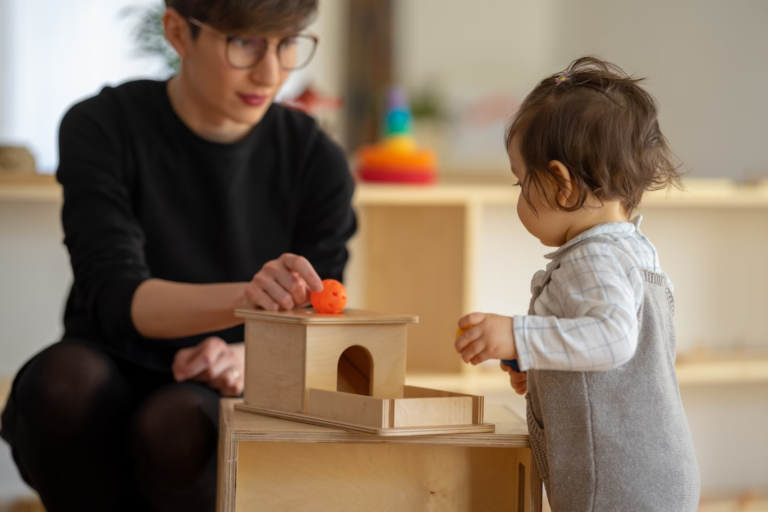What Did Montessori Mean by “Follow the Needs of the Child”?
If you’ve read about the Montessori method, you may have come across the phrase, “Follow the child,” or “Follow the needs of the child.” What does this mean?
Some interpret this phrase to mean that children can do whatever they want. Yet, if you take a deeper look at the Montessori philosophy, you’ll discover a different meaning. Whether you’re a parent, an educator, or contemplating Montessori teacher training, it’s beneficial to understand this basic Montessori concept.
Where Does the Phrase “Follow the Child” Come From?
When Dr. Maria Montessori transformed education in the early 1900s, teachers were traditionally at the center of the classroom. Montessori classrooms changed this, putting children at the center of learning.
Montessori approached teaching and education in a unique way. She had studied and trained to become a doctor, so she used a scientific approach. Instead of imposing learning objectives on children, she treated it more like an experiment. She provided different materials and lessons within the classroom and then observed the children, how they learned, and how they interacted with the environment.
Through this approach, Montessori discovered that through their actions and behaviors, children showed her what they needed. She carefully picked materials and lessons that aligned with the child’s needs. Additionally, she aligned her whole method to her observations. In other words, she followed the children!
In her writing, Montessori alludes to this approach. She once wrote, “Anyone who wants to follow my method must understand that he should not honour me but follow the child as his leader.” With this, Montessori meant that to be a good teacher, you have to do more than copy another teacher. Instead, people training to become Montessori teachers should observe children.
Another time she said, “Follow the child, they will show you what they need to do, what they need to develop in themselves and what area they need to be challenged in.” In other words, through observation, teachers can see what children need. By watching children carefully, teachers can provide the right learning experiences at the right time.
How Can Montessori Teachers “Follow the Needs of the Child”?
Putting the idea of “following the child” into practice involves many steps. Here are our top tips for people in Montessori teacher training:
Observe the Child with Curiosity
Montessori once said, “Respect all the reasonable forms of activity in which the child engages and try to understand them.” By this, she meant that as adults, we should be curious about a child’s behavior. Instead of assuming they’re being naughty or mischievous, we should try to understand their behavior.
Sometimes, children do things that seem strange to adults. Other times, we might believe children are misbehaving or that they want to annoy us. Yet, if we observe the child’s behavior with curiosity, we can understand the “why” behind it.
For example, a child might spin in circles because they need sensory input, not because they want to disrupt the class. Or, a child might distract others because they’re bored and don’t know what to do. Over time, Montessori teachers learn to recognize behaviors and the possible reasons behind them. It all starts with curiosity.
Trust the Child’s Drive to Learn
While developing her method, Montessori also discovered that children naturally want to learn. It’s a natural process for them. They enjoy learning and almost all children, when provided with the opportunity and materials, will choose to learn to read, count, and more.
Consider the amazing things children learn largely on their own. Babies begin to learn to speak just by hearing their parents. A similar process can happen when learning to read and write. This is why Montessori’s reading and writing materials focus on activities young children can often do on their own and involve movement (young children are almost always moving!). She believed young children were naturally interested in language and would enjoy activities that would help them learn to read and write.
Montessori also noticed that when children get the chance to choose to learn, they are more motivated. When a child decides to do an activity, they’re excited to do it. It makes learning much more fun and engaging.
Montessori teachers know to trust the child’s drive to learn. They carefully watch for the signs that a child is ready to learn about a new topic or explore a new theme.

Boost Motivation by Introducing Topics at the Right Time
Similarly to trusting the child’s drive to learn, Montessori teachers introduce topics at the right time. Teachers do this by preparing the classroom with the right materials and lessons. Then, they observe students.
For example, a child who works on counting activities may soon be ready to learn to add. Or, a child who scribbles and pretends to write may be ready to work with the metal insets and the sandpaper letters. Montessori teachers use the child’s interests to their advantage.
It’s similar to how adults may enjoy hobbies. Imagine you enjoyed painting with watercolors. Then, one day, at your job, someone did a watercolors workshop. They might also bring a variety of paintbrushes and new, better-quality paints. It would be so exciting! This is how children feel when their teachers notice and encourage their interests.
Adjust the Environment
“Following the child” goes beyond how a teacher or caregiver interacts with children. Montessori teachers also adjust the environment, or classroom, to meet the child’s needs.
One of the main important aspects of adjusting the environment is providing engaging, interesting materials and lessons. In Montessori classrooms, one of the most important areas is the Practical Life curriculum. Children can work on spooning grains, pouring liquids, dressing frames, and other practical skills. Part of the fun and interest in this area is changing the materials. Every week, teachers may change the grains, bowls, pitchers, etc. to make things more engaging. For example, one week, students might work on moving pompoms with wooden tongs from one bowl to another. The next week, the teacher might invite children to try moving the smaller pom poms with a tweezer.
Additionally, Montessori teachers must constantly monitor the classroom to ensure it provides enough challenges for students. One of the main reasons children may misbehave is boredom. So, Montessori teachers work hard to provide a wide range of exciting lessons that awaken the child’s interest to learn.
View the World from the Child’s Perspective
Finally, Montessori teachers can “follow the child” by trying to see the world through a child’s perspective. One way to do this is to routinely reflect on how children engage with each other and the classroom. Here are some helpful questions:
- Do students gravitate to one area of the classroom?
- How are the children getting along with each other?
- Are children picking work from all curriculum areas?
- Are children following the classroom routines? Why or why not?
- How can the flow of the classroom be improved?
- How might the child’s life outside of school influence their behavior in school?
By considering these questions, Montessori teachers can make changes to their classrooms and interactions with students.
Examples of “Following the Needs of the Child”
There are many ways to follow the needs of the child. Here are a few examples:
- Dinosaur Lover
Imagine your child loves dinosaurs. How might you take advantage of this interest? In the practical life area, you can add a station where children can clean off fossils using a brush. Or, you can invite your child to learn how to make an imprint fossil using salt dough and leaves, pinecones, and other objects. Plus, you can include 3 part dinosaur cards in the science area so that the child can practice both reading and matching pictures. The sky’s the limit! The important thing is to add activities that include the child’s interests. - Playing in Water
You might notice that a child always lingers when washing their hands, playing in the water. You can invite the child to explore this interest with pouring activities. They can pour water from a pitcher into a glass. Or, you might invite them to wash dishes. - Observing Instead of Interfering
One big part of following the needs of the child is not interfering. Perhaps you notice a child struggling to tie their shoes. It may seem like they need help! But, before interfering, it’s important to notice whether the child seems frustrated. Do they really need help? Or are they learning through the process of trying to tie their shoes? Children can enjoy the process of learning and may have a high threshold for frustration. It’s often best to wait for a child to ask for help instead of interrupting them while they’re concentrating.
Learn to Follow the Child with Online Montessori Teacher Training
Parents and teachers can meet the needs of their children better by learning to follow them. This doesn’t always come naturally. In our society, adults are supposed to be in charge and tell children what to do. While that may be necessary in some cases, we can help children learn and grow into respectful adults successfully by observing their behavior with curiosity. When we observe children, we can discover what they might need and help them reach their goals.
Online Montessori teacher training can help parents and educators learn strategies to follow the child effectively. Through training, you can learn about early childhood development and gain a deep understanding of the Montessori curriculum. Plus, you’ll learn to use Montessori principles to foster a calm, productive learning environment.
Are you ready to start your journey? Learn more about our Montessori training courses here.







